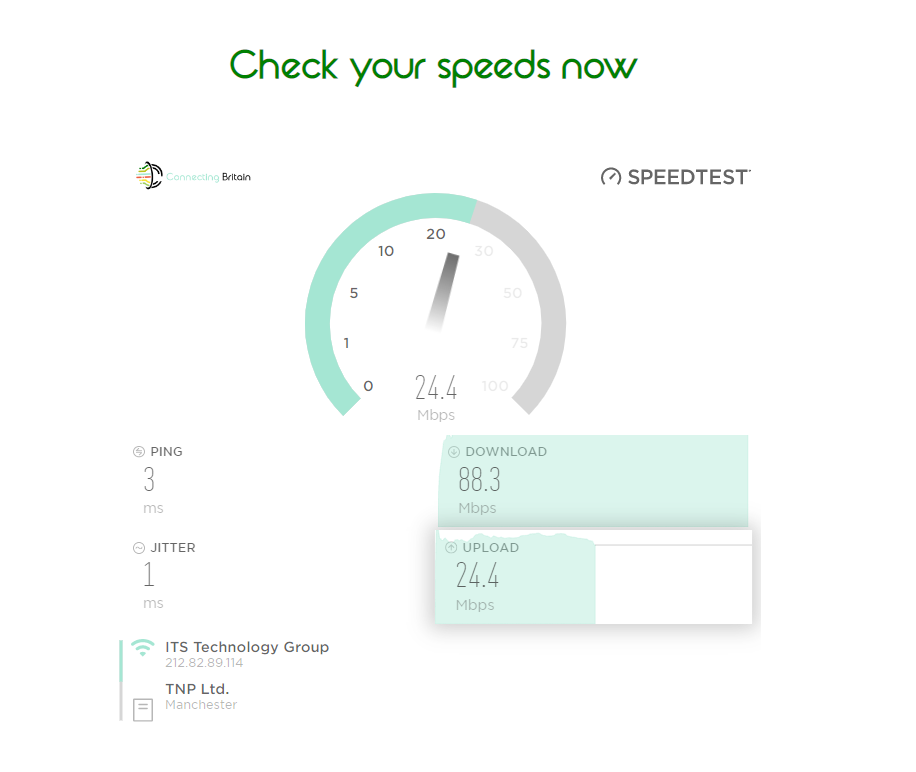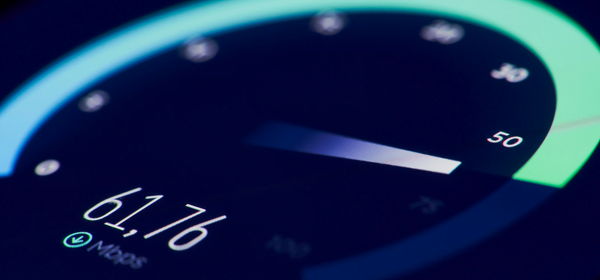Have you ever tested your business broadband speeds?
If not, here’s how.

What do I need to test my Broadband Speed? –
There are lots of ways available to test the speed of your internet connection and it only takes a minute of your time. Things to consider before testing your broadband speed; whether you’re testing on a computer or phone. If you’re connected through the Wi-Fi or a wired connection.
- If you are testing your broadband speed on a computer or laptop, is it connected to the internet through the Wi-Fi or through a cabled connection? This can influence the result you receive when running the test.
- The most accurate result will be given if testing on a computer with a wired connection. This is due to less interference or fluctuations which can occur through the Wi-Fi.
- The best way to test on a Wi-Fi connection is to make sure that no downloads are running and that you’re not connected to any VPN software.
Running the Test –
By using our very own speed tester you are able to check your download and upload speeds through our website.
In order to access this you must first input your email and postcode (please note the speeds will be determined by the connection you are wired into/connected to via Wi-Fi, not the postcode you enter). We do this to reduce spam and to ensure you’re human, of course.

What do the numbers even mean? –
The main two values that we want to know most when running a broadband speed test are the Download and Upload speeds of the connection. But what do they mean?
The Download speed is the first value that the test will show. This value shows us how quickly the connection can transfer data (download data) from the internet to your device. Download speed matters for activities such as watching videos or browsing sites etc.
The upload speed is the second value that we want to find out. This value shows the speed for what it takes to send data from your device to the internet. Upload speed would matter when you’re uploading photos or video calling etc.
- The most likely measurement that you will see is Megabits per second (Mbps).
- If you struggle with your speeds a lot, you may see Kilobits per second (Kbps). This is the lowest measurement you’d see and indicates that the connection is very poor. This result is most likely to be seen when your connection is an ADSL (traditional copper).
- Alternatively, if you are on a high-speed business connection such as a Leased line you may see Gigabits per second (Gbps). If your broadband speed is in this range, it shows that you have a Full Fibre connection.
The download speed will almost always be a larger figure then the upload as it is more important to the average internet user. This may differ with some business connections but rather than see a larger upload speed, the industry standard would be a parallel connection with equal speeds both ways.

The most common question – Is my Internet speed fast?
Something that our speed test can tell you (if you don’t already know) is what kind of broadband connection you are currently on. If you do already know what connection you’re on it can help determine whether you’re receiving the correct speeds.
We would say that any speeds from 1mbps to 20mbps download is a very slow connection. This may indicate that you are on a copper ADSL connection which is outdated and unreliable. Anything above 20mbps Download indicates some form of fibre connection.
There are many different connections available when it comes to fibre broadband, dependant on provider. When considering a new business connection, you’ll need to think of the overall internet usage of your staff and how many people within the business would be reliant on the internet connection to carry out their day to day activities.
Everyone’s broadband packages are different and therefore it’s hard to say whether your connection is ‘fast’ without taking other factors into account. A speed test can however show you whether you are receiving the speeds for which you are paying.
Why do my speed results change?
The results shown will be a snapshot of your connection in that moment. Things can happen throughout the day that affect the results. You may see peaks and troughs at different times of day, this could be due to the amount of people using the network at peak times of the day, this is something we call contention.
Contention is how we explain the rate of other people being connected to the same part of the network as you. For example, a residential connection typically has a higher contention rate than a business broadband connection because there will be more people connected in a smaller area.

If the speeds, you are receiving do not meet your requirements. It is worth looking into other available options within your area to improve the reliability and/or speed of your connection. There are hundreds of options available nationwide through multiple different providers.
If you are a business looking to improve your broadband connections, we at Connecting Britain offer a wide range of options for high-speed internet and are partnered with some amazing networks throughout the UK to bring Full Fibre into areas where it isn’t currently available.
If you are curious as to what is available within your area, feel free to use our postcode checker or get in touch with one of our connectivity specialists to see what we can do for your business.

